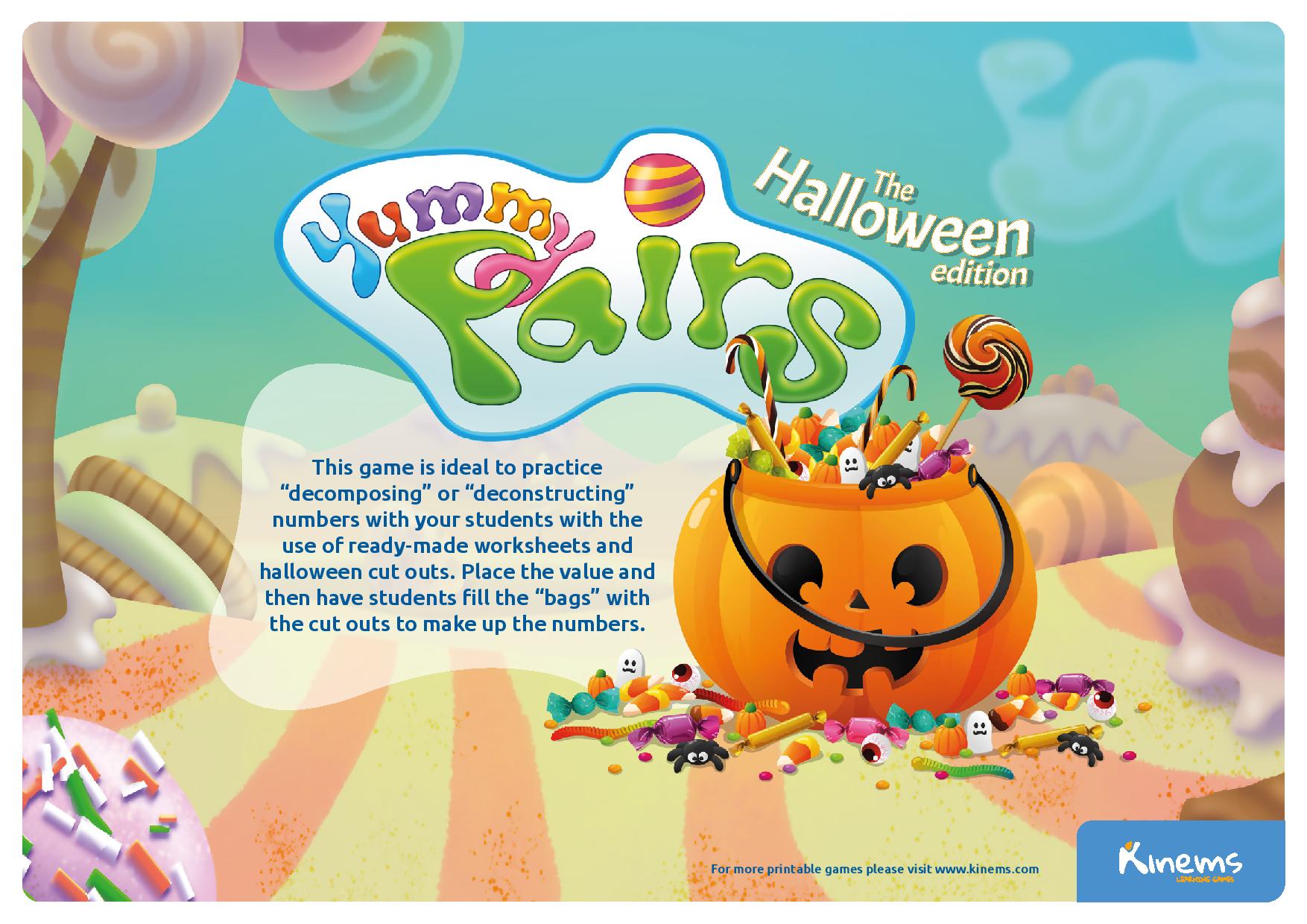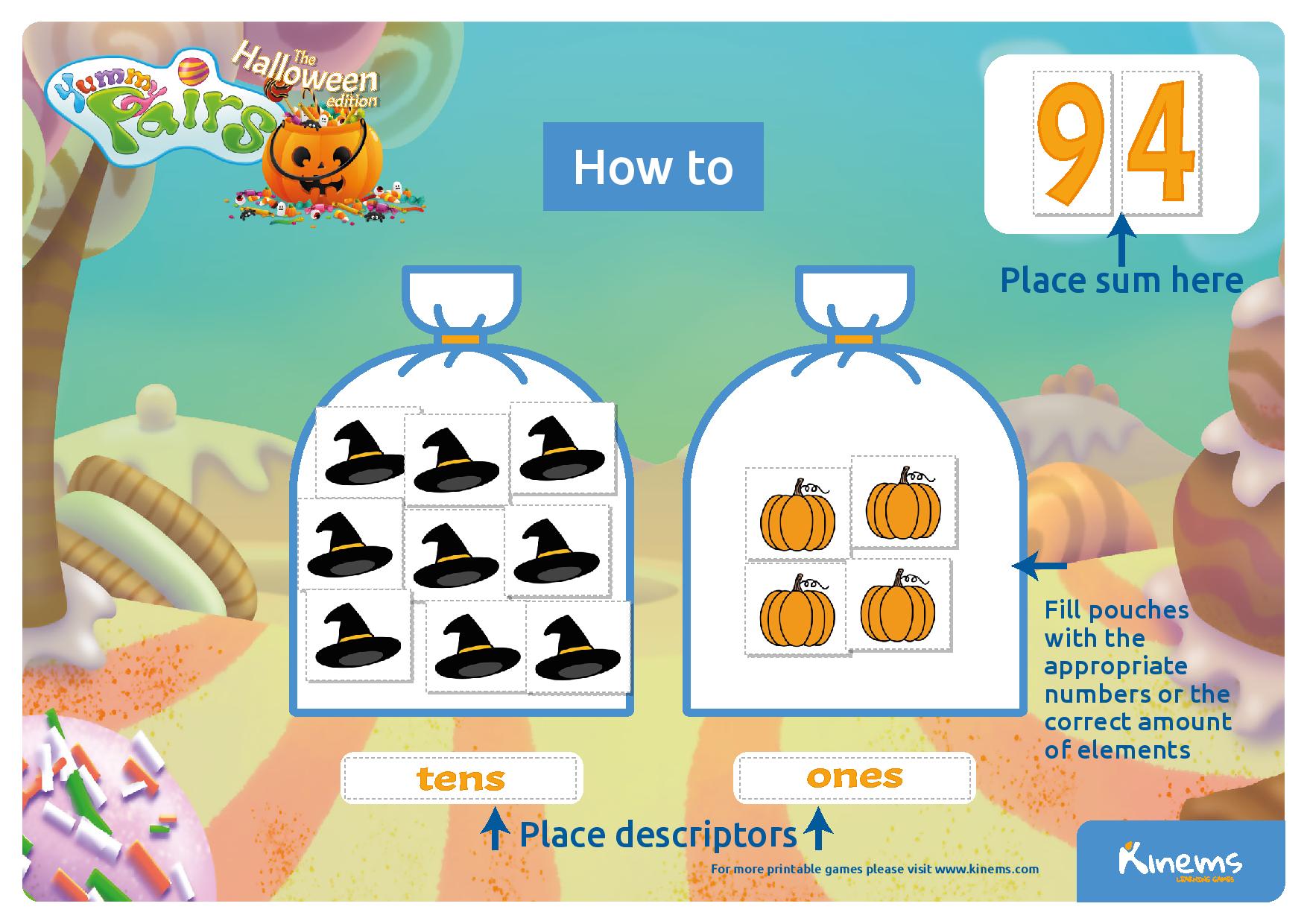Free Printable Board Game for Math for Kindergarten & 1st Grade | Yummy Pairs: Halloween Edition

Keep your little monsters busy and engaged this Halloween.
Math will be a TREAT as students practice one of the most important fundamental math concepts for the early grades using these fun games and activities!
In the Yummy Pairs Game: Halloween Edition children use ready-made worksheets and Halloween cut-outs to practice “decomposing” or "deconstructing" numbers that appear as positive integers or quantities using the ten-frame representation. This means they will explore the pairs of number combinations that make up the number.
This is an ideal board game for kids to not only learn one of the most important fundamental math concepts but also spend time playing it with the whole family at home, as well as in the classroom.
The Yummy Pairs character lives in an imaginary world of candies. Your kids will use the board games to create number combinations depending on their current understanding of numbers from 1- 9 and then 10-19 and onward to other representations of tens and ones.
Select the range of target numbers that your child will be asked to make and the difficulty level that involves representing the available pairs of numbers from which the student will choose. This game offers unique learning experiences to the children about how numbers can be broken apart and put back together.

Game One:
In this game use the Halloween objects to represent pairs of numbers that make up numbers 1-10. Place a number between 1 and 10 in the top right corner “target” number space. Then place the label “ones” under each of the two bags for candies on the game board from page 2. Using the candy counters represent and count out the numbers. So if the number is seven, they can place three candies in the first bag and 4 in the second. Grab the corresponding numerals and put them in the bag with the candies. Make all of the factors of 7 (6+1, 2+5, 0+7, and then reverse them into 4+3, etc).
Game Two:
If your child is ready to understand tens, you can use ten hats to represent the ten and then pumpkins to represent the ones. In this way, you begin to teach that 11-19 are made up of ten and ones. But use the label “ones” in both until your child has the “ah-ha” moment that every one of the “tens” have the 10 and when you write the number, the 1 always represents the ten. Then you can place the 1 in the bag you label “tens”. So for 15 up in the right hand corner, you then place the “tens” label under the left bag and the “ones” label under the right hand bag. You can then place the numeral 1 to represent the 10 elements in the tens bag and put 5 elements in the right hand bag. Keep practicing with all of the tens until the concept is clear.
Game Three:
Once you have the teens done, you can begin on the concept of the numbers 1-99. You can use the same concept of either the numeral or the elements representing the tens and the elements representing the ones. Continue practicing. Have your child quiz you by putting up the target number.
Game Four:
If your child is ready for the game board from page 3, introduce hundreds starting with ten tens or 100. We have included additional activities to reinforce these number concepts. Use the template to explore decomposing numbers from 100 to 999.

This game aligns with these learning goals on the kindergarten and first grade level
Kindergarten Math Standards
- For any number from 1 to 9, find the number that makes 10 when added to the given number, e.g., by using objects or drawings, and record the answer with a drawing or equation.
- Compose and decompose numbers from 11 to 19 into ten ones and some further ones, e.g., by using objects or drawings, and record each composition or decomposition by a drawing or equation (such as 18 = 10 + 8); understand that these numbers are composed of ten ones and one, two, three, four, five, six, seven, eight, or nine ones.
- Compose numbers from 11-19 from a group of ten ones and additional ones using objects.
- Decompose numbers from 11-19 into a group of 10 ones and additional ones using objects.
- Print numbers from 0-20 when prompted
- Recognize numbers from 11-20 out of sequence. Count up to 20 objects that are in an order by answering the question “how many”.
Grade 1 Math Standard
Understand that the two digits of a two-digit number represent amounts of tens and ones.

Suggested additional activities to introduce/reinforce or re-teach these concepts
Concepts of 10
- Take Cuisenaire rods or counters to make combinations of ten. You can use found materials such as water bottle tops and bingo chips. How many combinations can be made? Use food like cereal, goldfish crackers, candies and other small items as counters that can be eaten after correct answers!
- Use the heart candies with the cards from Who’s Counting?: Numbers with Dots 1-20. Ask your child to place the hearts on the dots corresponding to the number.
- Practice counting together, clapping out the number. So one is one clap, say two and clap two times, say three and clap three times and so on.
- Count the plates for dinner, the forks, the spoons, etc.
- Count everything you can think of and place the number you cut from the numbers next to the items. Go on a nature walk and count the trees, leaves, plants, etc.
- Count the doors in your house, the drawers in your room, the cabinets in the kitchen.
- Ask family members to make predictions about how many there are of each of these and make a list to see who wins the prediction.
- Get a blank sheet of paper. Do a number of the day and represent that number by cutting and gluing objects from magazines or flyers that represent that number. Hang it on the fridge or other display area.
- Make “equations” that represent the number combinations that make up each number up to 10. You can use the same concept of cut objects and glue them above or below the number. For example, 3 cans of beans + 4 boxes of cereal = 7 items on the shopping list!
- Help your child to print the numbers themselves. You can download worksheets from the internet or make dotted or dashed numbers they can complete with crayon or magic marker. You can also make stencils from empty clean plastic milk containers. Practice in the air or with water in the bathtub. Use Play Doh to make snakes that can be placed on the table to represent numbers. Use yarn to glue in the shapes of numbers.
Counting by tens and using tens to represent two digit numbers
- Have the students count the candies to represent 10 and then 20.
- Count to 100 by adding ten every day. Start with 1-10. Add the teens and then 20. Clap or make a sound or jump at 10 and 20. Add 10 more each day until you get to 100 and clap or make something special about each factor of 10.
- Using these resources, your students will make two digit combinations.
- Make a fun song of counting by tens! Count by 5s!
- Take out a calendar and see what day it is. Represent that day as a number. If it is a day in the teens or 20 or 30, make an equation to represent that number. Review the date every day.
- Check the weather. Represent the temperature as a number with tens and ones.
- Count the chips in a bag of chips or cookies. Organize them by 10s.
- Get a jar and fill it with beans or candies. Make sure it is more than 100. Put a lid on it and seal it. Have family members guess how many are in the jar. Take down the guesses with the names of the person. You can use facetime to show it to friends so more people get to guess. Then have your child open the jar to count it with you. You can make a ceremony of the counting. Arrange the items in groups of 10. Then tally the groups and come up with the amount. See who came closest to the prediction and decide on the “prize”. How did they estimate?
Pulling apart numbers into factors
Once your students understand how to make the number combinations, try asking to pull the number apart. So give them the number 17 and have them choose the tens and ones that make up 17. Do the same with various numbers. They are “decomposing” the number. They are pulling apart the numbers that make up the number.
Please leave your contact information below to download the free printable board game now:
Enjoy learning with Yummy Pairs: Halloween Edition!